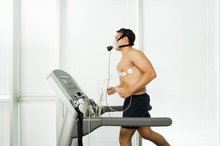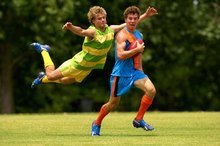Active Heart Rate for Teens
Physical activity can help your teen stay fit and active. At rest, the average heart rate for a teenage girl or boy is between 60 and 90 beats per minute according to the University of Missouri Health.
Proper pacing during exercise can ensure your teen gets a challenging workout without burning herself out. Monitoring her heart rate provides one measure of how hard her body is working. It can also provide an idea of your teen’s overall health – a high heart rate when active is normal, but one that is high during periods of inactivity can indicate an overconsumption of caffeine or even illicit drug use.
Normal Heart Rate by Age
Adults who are 17 years old or older have an average resting heart rate of 60 to 100 beats per minute. Those younger than 17 may have a faster heart rate. A teen’s heart rate varies depending upon her age and conditioning. The resting average heart rate for teens can range between 50 to 60 beats per minute to as high as 90 to 100.
When active, the maximum heart rate for a teen — the highest amount his heart can safely beat per minute — is about 200 to 205. You can obtain the exact number by subtracting your teen’s age from 220. An extremely active and fit teen will normally have a lower active heart rate than one unaccustomed to exercise.
Read More: Athletes Vs. Non-Athletes Heart Rate
- Adults who are 17 years old or older have an average resting heart rate of 60 to 100 beats per minute.
- A teen’s heart rate varies depending upon her age and conditioning.
Heart Rate During Exercise
Normal Pulse Rate for Teenagers
Learn More
To maximize the cardiovascular and fat-burning benefits of exercise without overdoing it, most teens will want to aim for an active heart rate within 50 to 85 percent of their maximum. This heart rate, defined as the “target” heart rate by the American Heart Association, can provide a measure of the impact of your teen’s physical activity upon his heart rate. The target heart rate for a healthy 16-year-old will fall between 102 and 173, depending upon his fitness level and the type of exercise.
Read More: Why Is Exercise Important to Teenagers?
- To maximize the cardiovascular and fat-burning benefits of exercise without overdoing it, most teens will want to aim for an active heart rate within 50 to 85 percent of their maximum.
- The target heart rate for a healthy 16-year-old will fall between 102 and 173, depending upon his fitness level and the type of exercise.
High Heart Rate
A chronically high heart rate, even during periods of inactivity, does not automatically mean your teen is ill or using illicit drugs. Although marijuana, cocaine and other drugs can increase your teen’s resting heart rate, anxiety and overconsumption of caffeine can also elevate her resting heart rate to active levels. Contact your teen’s doctor if you notice a regularly elevated heart rate, especially if accompanied by agitation or dizziness.
Monitoring Heart Rate
Normal Pulse Rate at 13 Years Old
Learn More
Monitoring his heart rate during exercise sessions can help your teen keep his active heart rate within the target zone. Although your teen can measure his heart rate by placing his hand on his pulse and counting the beats per minute, a heart monitor can provide a more accurate and convenient way to measure the pulse. Since many teens like technology, using a gadget like a monitor can spur interest in exercise and physical health.
When to Consult a Doctor
Health conditions like hyperthyroidism and paroxysmal atrial tachycardia, a cardiac condition in which the heart’s upper part sends out rapid electric signals, can cause your teen’s active and resting heart rate to be high. These conditions require comprehensive medical evaluation and treatment to avoid further complications, so report any concerns relating to your child’s heart rate promptly to her doctor.
Related Articles
References
- American Heart Association: "Know Your Target Heart Rates for Exercise, Losing Weight and Health"
- Romero SA, Minson CT, Halliwill JR. The cardiovascular system after exercise. J Appl Physiol (1985). 2017;122(4):925–932. doi:10.1152/japplphysiol.00802.2016
- Nystoriak MA, Bhatnagar A. Cardiovascular Effects and Benefits of Exercise. Front Cardiovasc Med. 2018;5:135. Published 2018 Sep 28. doi:10.3389/fcvm.2018.00135
- Füzéki E, Banzer W. Physical Activity Recommendations for Health and Beyond in Currently Inactive Populations. Int J Environ Res Public Health. 2018;15(5):1042. Published 2018 May 22. doi:10.3390/ijerph15051042
- De meersman RE. Heart rate variability and aerobic fitness. Am Heart J. 1993;125(3):726-31. doi: 10.1016/0002-8703(93)90164-5
- American Council on Exercise. Physical Fitness Assessments. Health Coach Manual. 2013.
- American Heart Association. All About Heart Rate (Pulse) January, 2018.
- Nate Brookreson. American College of Sports Medicine. ACSM Certification. "Using Heart Rate Monitoring For Personal Training." July 2015.
Writer Bio
As a global nomad with experience living and raising children in China, the USA and Europe, Erin Carson loves to share her knowledge of both literature and travel through her writing. Carson has a master's degree in library science and a bachelor's degree in English literature. As a freelance writer, Carson has published numerous articles on various health, parenting and travel websites.








